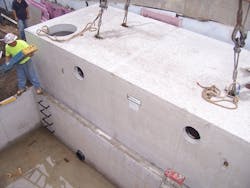The Forest House development in the Bronx is part of Mayor Michael R. Bloomberg’s $7.5 billion New Housing Marketplace Plan to provide affordable housing for 500,000 New Yorkers. Forest House is a nine-story, energy-efficient, precast concrete building with affordable housing units and a landscaped open space with an underground parking area. A unique feature of the Forest House development is the incorporation of a large rooftop hydroponic greenhouse that will yield between 80,000 and 100,000 lb of fresh produce each year for distribution to residents and local markets.
Storm Water Management
Once developed, the approximately 2/3-acre site will be a virtually 100% impervious area with storm water runoff draining into the city’s combined sewer system. Like many older cities with combined sewer systems, rainfall events in New York City place a tremendous burden on the municipal wastewater treatment plants. According to Forest House MEP engineer Chris Sideris, in keeping with New York City’s Site Connection Regulations, a detention tank was required to slow rainwater runoff from the site to reduce impact on the treatment plants associated with rain events.
“We saw the detention requirement as an opportunity to explore rainwater harvesting as a means to reduce the significant potable water demands of the hydroponic greenhouse system,” said Les Bluestone, principal with developer Blue Sea Development LLC.
In this situation, the harvesting system not only would reduce potable water demand, but also prevent a significant amount of storm water runoff from entering the combined sewer system, thereby reducing the load on the municipal wastewater treatment plant and the incidence or magnitude of combined sewer overflows. Blue Sea relied on its longtime vendor Oldcastle Precast to provide the complete harvesting system.
Solution Provided
With limited site space at Forest House, Oldcastle’s underground storm water retention tanks were a good fit for installation under the down ramp into the below-deck parking garage. Total storm water storage provided by the dual-tank system is approximately 16,000 gal. To further reduce footprint issues, the precast cistern system was constructed with a secondary internal chamber to provide outlet control and separation from the combined sewer system.
Rainwater runoff from rooftop downspouts and landscape area drains will be delivered through 8-in. pipes to downspout filters and on to the underground cistern. The downspout filters will prevent coarse sediment particles, leaves and other debris from entering the cistern. Once inside the cistern, a small transfer pump will transfer the harvested water to the central processing skid located in a utility closet in the basement of Forest House.
The processing system will incorporate a polishing filter system, ultraviolet (UV) disinfection, day tank and booster pumps. The polishing filters are used to remove any fine particles that might interfere with fixture function. The UV disinfection system will ensure that no harmful bacteria exist in the harvested water, and the day tank will provide a connection location for the municipal water backup supply to the greenhouse. The energy-efficient booster pump will provide sufficient pressure and volume of water to the rooftop greenhouse facility. The harvesting system will function from a central control panel that will provide pump and valve control, monitor equipment function and operational reports, and send data both locally and to the building automation system.
The entire processing system, designed and fabricated by Oldcastle partner Water Harvesting Solutions (Wahaso), will come pre-assembled to the project site for rapid installation.
Maintenance
A key requirement of Blue Sea was to minimize the amount of maintenance required by the building staff to keep the system working properly. Wahaso’s design automated as much of the system as possible.
“The polishing filter will automatically determine when it needs cleaning and then backflush itself,” said Stuart Bailin, director of engineering for Wahaso. “The UV bulbs have a 10,000-hour useful life, so they will only need changing every two to five years. We even incorporated an automatic wiper system for the UV bulb to maintain optimum effectiveness for the sanitation system.”
The underground cisterns were installed in July 2011, and the remaining harvesting system components are scheduled to be completed in May 2012. Once operational, the harvesting system is anticipated to supply approximately 50% of the water used by the hydroponic greenhouse, or more than 300,000 gal per year—a significant reduction in municipal potable water usage. In addition, the system will prevent those same 300,000 gal of storm water from entering the combined sewer system and either contributing to combined sewer overflows or going through treatment at the municipal wastewater treatment plant.
Further System Enhancements
One concern in using storm water detention volume for retention and onsite use is ensuring that sufficient storage capacity is available in the cisterns to hold storm water from an upcoming precipitation event. Volume available for upcoming storm water flow mitigation is reduced by any remaining storm water retained in the storage system from previous rain events.
Geosyntec Consultants of Brookline, Mass., is working with Blue Sea on a New York City Department of Environmental Protection-funded grant that was awarded for the harvesting system to implement an active control system on the discharge port from the Storm Capture cistern. Geosyntec’s system monitors local weather predictions and real-time system status, and anticipates the amount of detention volume required for an impending storm event. By comparing the incoming storm’s projected volume, intensity, duration and timing with storage available in the cistern and its known drawdown characteristics, the system then automatically opens and closes an actuated valve to release enough stored water to make room for the incoming storm water. This type of active control system can reduce the amount of total detention and retention storage volume and get the most value out of the mandated detention requirement.
Steve Kingsland is National Water Group product manager for Oldcastle Precast. Kingsland can be reached at [email protected] or 508.344.4333.
Download: Here
